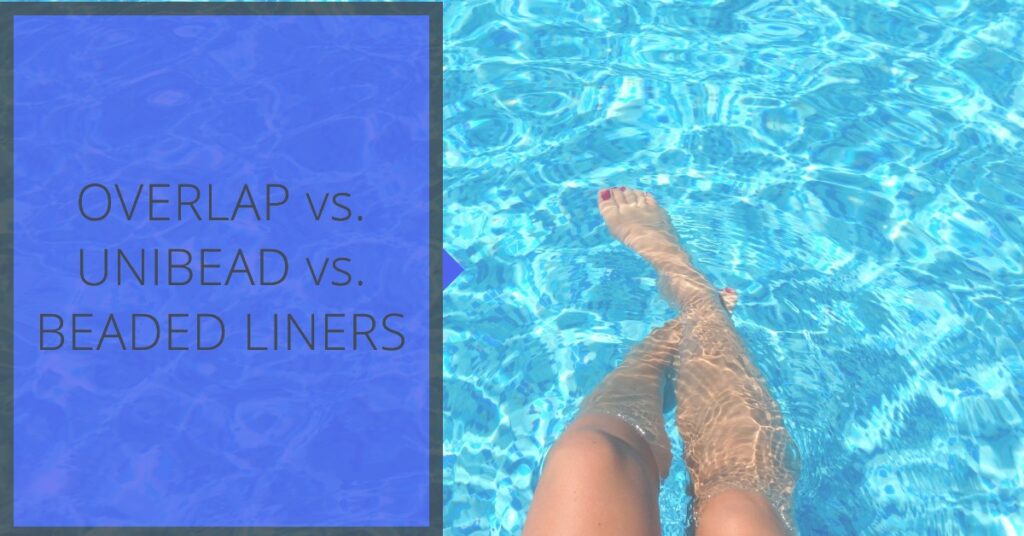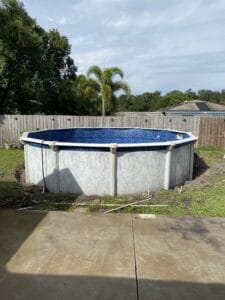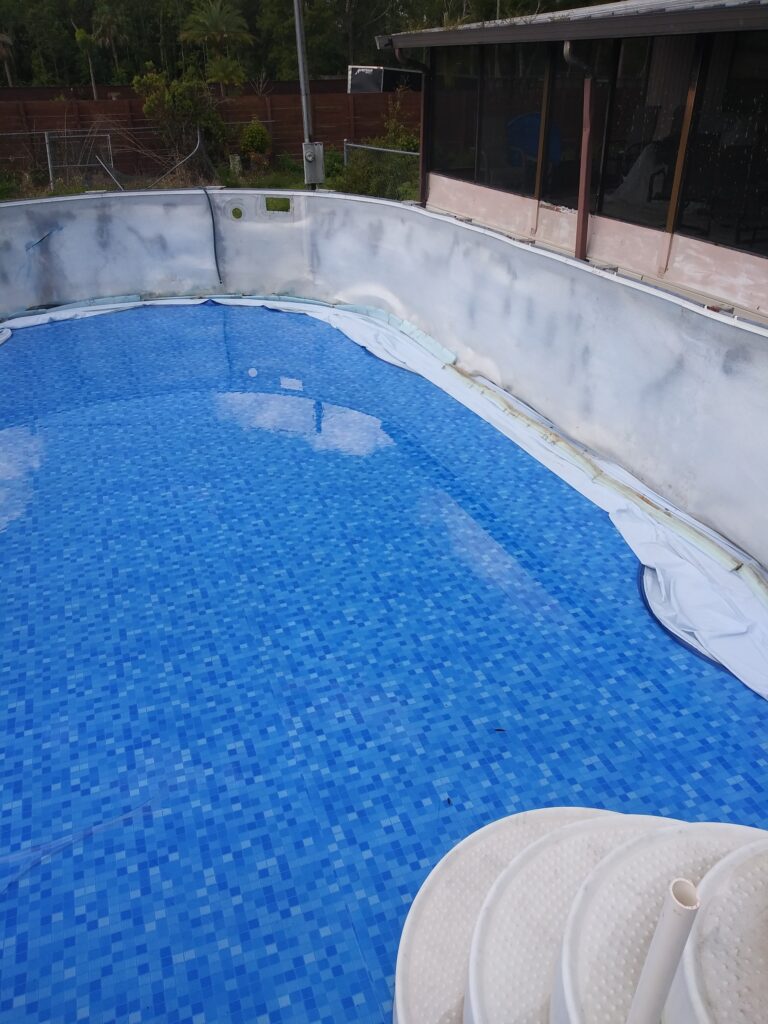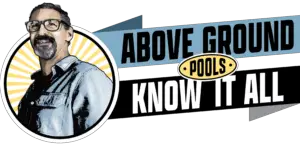
When it comes to above ground pools, there are four types of liners that you can have. Some are more common than others. Some I recommend over others depending on the situation. Here’s a breakdown:
THE FOUR TYPES OF LINERS FOR ABOVE GROUND SWIMMING POOLS
1 OVERLAP LINER
This is the original liner type for above grounds. When I started building pools in the eighties, the overlap was about all there was. They also all came in solid blue only, then I started seeing some liners with patterns in them and that was cool.
With all the progress we have had in our time, there are some things where the original is still the best. This is NOT the case with the OG overlap liner. Liners since have definitely been improved upon.
An overlap type liner is exactly what it is called. The liner is placed in the pool and is designed to have some excess material at the wall. As the liner is set in place, the excess at the top is pulled over the wall and lays along the outside of the top of the pool. The liner is finally set by securing it at the very top of the wall with this thing called “coping strips”.
PROS FOR THE OVERLAP LINER
- Cost a little less
- May be better for installing in a misshaped or off level and poorly installed pool as more adjustments can be made when setting.
- Can be used for all wall heights including 48”, 52”, and 54”.
CONS FOR THE OVERLAP LINER

- Excess of liner can be visible on the outside of the pool making it less attractive and covering some of the outside design. NOTE: The excess of overlap liners may be rolled up and hidden under the top rails on some models.
- Requires coping strips (most brand new above ground pools come with coping strips, but they made need to be replaced when the liner needs replacement)
- May be slightly harder to install properly for the do-it-yourselfers
- Increased likelihood that the liner comes from China. ( and believe me, you don’t want that)
- Can be problematic when replacing in an existing above ground pool that is buried partially or fully in the ground.
2 Beaded liners
Beaded type liners have been around for a really long time. They just weren’t very common with above ground pools as they were only used with pools that came with aluminum wrap-around decks.
The concept of the beaded liner is a good one. It is designed to be secured into a track at the top of the inside of the pool. This makes it easier to change the liner as many of the top pieces of the pool will not have to be removed.
A beaded liner is exactly what it is called too. It is a liner with a thick piece of material (that is usually square or triangle shaped) all along the very top of the liner. This continuous thick material (bead) is designed to feed into a channel (bead receiver) that hangs down from the top of the pool’s wall on the inside.
Once the bead is secured into the channel all the way around the pool, the liner is now in place at the top.
In order to use a beaded liner, you must have the bead receiver or bead channel to go with it. This bead channel fits along the top of the pool’s wall and then hangs down along the inside where the actual receiver will hold the bead of the liner.
PROS FOR THE BEADED LINER
- Can be easier when replacing the pool’s liner
- Can have a decorative tile pattern
CONS FOR THE BEADED LINER
- Can cost a little more
- They can be harder to get as they are not as common
- Requires a bead receiver or bead channel
- There can be issues with the bead coming out of the channel with some receiver designs
- Can cause the inside of the pool’s wall to rust (Please read “Why I NEVER recommend a beaded type liner for and above ground swimming pool”)
3 J-hook liners
The J-hook type liner is the newest type of liner for above grounds. It’s the newest but it’s not new. I probably saw my first J-hook liner twenty years ago. I recommend J-hook type liners over all the others.
The J-hook liner (you may have guessed it) has a thicker piece of material continuously along the top of the liner shaped like a “J”. This thicker J part attaches to the top of the pool’s wall and is then secured by the pool’s top stabilizer bars pressing over it.
The J-hook liner then hangs down into the pool with only a small part of it (the back of the J) hanging over the outside of the wall. No part of this type of liner is visible on the outside of the pool’s wall.
PROS FOR THE J-HOOK LINER
- May be easier to install for the do-it-yourselfer
- Hangs completely over the pool’s wall which disallows any water from getting to the inside of the wall from the top.
- Can have a tile pattern
- Less likely to be made overseas
- Will usually be “fully printed” (having a print or pattern all over the liner – Not solid blue)
- Looks better on the outside of the pool because there is no excess liner visible.
- Doesn’t require coping strips
- Easy to convert during liner changeout or replacement
CONS FOR THE J-HOOK LINER
- Can cost slightly more
- Generally has to be specific to the height of the wall (unless you are a pro)
- Less forgiving when installing in a misshaped or extremely off-level pool
4 Uni-bead liners

In truth, I can’t be exactly sure as to why this type of liner is called “uni-bead”. I heard once from a supplier that the “uni” part is short for universal. This made sense to me so I started telling people that. So, now I’ll tell you the same.
The universal bead or “uni” bead for short is named so because it has both a J-hook AND a bead at the top of the liner. This makes it so the liner can be used in a J-hook or a beaded application.
The J-hook is at the very top of the liner and the bead runs directly underneath it. So, if you use the liner as a J-hook, then you don’t do anything except hang it over the top of the pool’s wall.
If using a uni-bead liner in a beaded application, you simply (but carefully) make a small cut along the top of the bead and then tear off the J-hook portion of the liner all the way around. There is an indention between the J-hook and the bead which allows you to easily and precisely tear off the J-hook.
Once the J-hook is off of the top of the liner, there is only the bead left. Now, you may proceed to use it as a beaded liner. Pretty cool.
PROS FOR A UNI-BEAD LINER
- Can be used as either a J-hook or a beaded liner. (Duh)
- Has all the pros for a J-hook liner (see above)
- Has all the pros for a beaded liner (see above)
CONS FOR THE UNI-BEAD LINER
- Requires an extra step when using as a beaded liner
- Has all the cons of the j-hook liner (when used as a J-hook of course)
- Has all the cons of the beaded liner (when used a beaded liner)
WHICH TYPE OF LINER DO I RECOMMEND – J-HOOK
Ninety-nine times out of a hundred, I’m going to recommend the J-hook liner (or a uni-bead and use the J-hook).
FOUR REASONS WHY I RECOMMEND THE J-HOOK
- The J-hook hangs completely over the pool wall. This is good because you don’t want the pool’s water to be able to get behind the liner and hang out against the inside of the pool wall. That’s a recipe for rust.
- The J-hook cannot be seen on the outside of the pool’s wall. Above ground pools are much nicer looking now then they were way back when I started installing pools. You don’t want liner showing on the outside of the pool. It’s ugly.
- The J-hook type liner is predominately made in North America. It can be hard to tell where a liner was made. Retailers won’t tell you it’s from China. Pro tip– You only want liners made in North America. Having a J-hook is not a guarantee that you have a North American liner, but it helps. Just in case, do what it takes to make sure your liner is made in the US or Canada.
- J-hook type liners are usually thicker, better quality liners. As a general rule, the heavier the liner, the longer it lasts before you have to replace it. Getting a J-hook(or a uni-bead) will help ensure that you got a better quality liner.
WHEN I RECOMMEND AN OVERLAP LINER
I’m not a fan of the overlap liner. They don’t look as good, require coping strips, and are a thing of the past. There are a couple of situations where I will recommend one.
THREE INSTANCES WHEN I WOULD SUGGEST AN OVERLAP TYPE LINER
- If you are looking to spend the absolute least on a liner (You’re broke). Some people have no money but need a liner. Others are selling their house and need a liner for the pool and don’t care how long it lasts. In these cases, I will direct you to the cheapest liner you can get which is the standard gauge, solid blue overlap liner.
- If the existing pool is in extremely out of shape and/or way off level. I have seen some really poorly installed above ground pools in my thirty-plus years of working with them. Some can be so bad that only the forgiveness of an overlap liner can be used to make it fit at least halfway decent.
- If the pool has a double deep center/end. Standard liners can stretch to accommodate about a one foot deeper center or end. Any deeper than that and the pool will need what is called an expandable liner. Expandable liners have extra material that will allow for a deeper pool and they only come as overlap types. You can get a custom-sized J-hook or Beaded liner to fit a super deep pool, but that is rare and expensive.
I RARELY RECOMMEND USING BEADED LINERS. VERY RARELY
There are a couple of higher-end above ground swimming pools that require a beaded liner. For those, I have no choice but to use them. There are other times when people have plans of putting their above ground in an area where they absolutely have to cover the top rails of the pool with something permanent.
When a situation like this happens where it would be extremely difficult to take the top rails of the pool off, then I may suggest a beaded liner. This is so it will be able to get replaced without having to take the top of the pool apart.
If this situation of not having access to taking the top rails off can be avoided, then I suggest avoiding it.

Hi,
Your explanations are very clear!
Here’s my issue…
I was wondering if a 15 x 31 beaded liner would fit into a 15×30 above ground pool with the existing coping? (I could get it at a 1/3 of the regular price!) The reason I’m asking is that my present overlapping liner I installed over 7 years ago is now pulling away from the copings (about 3 inches) in 3 different spots in between the vertical walls on one side (sun always shines on this part and probably shrunk the liner when the water level was low and not used for two years)? After cleaning and adjusting the liner, I was filling it overnight and in the morning I see it has separated from the (c)lip after filling it with about 3 feet of water. I’m also wondering if I could continue to fill the pool with the present liner or will the liner be pulled even more in and then a disaster will occur?
Thanks
Do you mean a 15x(30) beaded liner? I’ve never heard of a 15×31. If yes, then you can use a beaded-only liner using coping. You have to place the top of the liner over the wall and secure it with the coping like you would with an overlap type.
The issue here is that your tile pattern will now be higher than what it should be, which may look a little funny. That’s it though.